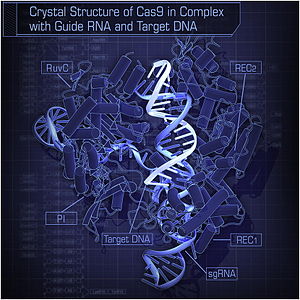
Cas9

Cas9 (CRISPR associated protein 9) is a protein which plays a vital role in the immunological defense of certain bacteria against DNA viruses, and which is heavily utilized in genetic engineering applications. Its main function is to cut DNA and therefore it can alter a cell's genome. Cas9 (CRISPR associated protein 9) is a protein which plays a vital role in the immunological defense of certain bacteria against DNA viruses, and which is heavily utilized in genetic engineering applications. Its main function is to cut DNA and therefore it can alter a cell's genome. More technically, Cas9 is an RNA-guided DNA endonuclease enzyme associated with the CRISPR (Clustered Regularly Interspaced Short Palindromic Repeats) adaptive immunity system in Streptococcus pyogenes . S. pyogenes utilizes Cas9 to memorize and later interrogate and cleave foreign DNA , such as invading bacteriophage DNA or plasmid DNA. Cas9 performs this interrogation by unwinding foreign DNA and checking for sites complementary to the 20 basepair spacer region of the guide RNA. If the DNA substrate is complementary to the guide RNA, Cas9 cleaves the invading DNA. In this sense, the CRISPR-Cas9 mechanism has a number of parallels with the RNA interference (RNAi) mechanism in eukaryotes. Apart from its original function in bacterial immunity, the Cas9 protein has been heavily utilized as a genome engineering tool to induce site-directed double-strand breaks in DNA. These breaks can lead to gene inactivation or the introduction of heterologous genes through non-homologous end joining and homologous recombination respectively in many laboratory model organisms. Alongside zinc finger nucleases and TALEN proteins, Cas9 is becoming a prominent tool in the field of genome editing. Cas9 has gained traction in recent years because it can cleave nearly any sequence complementary to the guide RNA. Because the target specificity of Cas9 stems from the guide RNA:DNA complementarity and not modifications to the protein itself (like TALENs and Zinc-fingers), engineering Cas9 to target new DNA is straightforward. Versions of Cas9 that bind but do not cleave cognate DNA can be used to locate transcriptional activator or repressors to specific DNA sequences in order to control transcriptional activation and repression. Native Cas9 requires a guide RNA composed of two disparate RNAs that associate – the CRISPR RNA (crRNA), and the trans-activating crRNA (tracrRNA) . Cas9 targeting has been simplified through the engineering of a chimeric single guide RNA (chiRNA). Scientists have suggested that Cas9-based gene drives may be capable of editing the genomes of entire populations of organisms. In 2015, Cas9 was used to modify the genome of human embryos for the first time. To survive in a variety of challenging, inhospitable habitats that are filled with bacteriophages, bacteria and archea have evolved methods to evade and fend off predatory viruses. This includes the CRISPR system of adaptive immunity. In practice, CRISPR acts as a self-programmable restriction enzyme. CRISPR loci are composed of short, palindromic repeats that occur at regular intervals composed of alternate CRISPR repeats and variable CRISPR spacers between 24-48 nucleotides long. These CRISPR loci are usually accompanied by adjacent CRISPR-associated (cas) genes. In 2005, it was discovered by three separate groups that the spacer regions were homologous to foreign DNA elements, including plasmids and viruses. These reports provided the first biological evidence that CRISPRs might function as an immune system. Cas9 has been used often as a genome-editing tool. Cas9 has been used in recent developments in preventing viruses from manipulating hosts’ DNA. Since the CRISPR-Cas9 was developed from bacterial genome systems, it can be used to target the genetic material in viruses. The use of the enzyme Cas9 can be a solution to many viral infections. Cas9 possesses the ability to target specific viruses by the targeting of specific strands of the viral genetic information. More specifically the Cas9 enzyme targets certain sections of the viral genome that prevents the virus from carrying out its normal function. Cas9 has also been used to disrupt the detrimental strand of DNA and RNA that cause diseases and mutated strands of DNA. Cas9 has already showed promise in disrupting the effects of HIV-1. Cas9 has been shown to suppress the expression of the long terminal repeats in HIV-1. When introduced into the HIV-1 genome Cas9 has shown the ability to mutate strands of HIV-1. Cas9 has also been used in the treatment of hepatitis b through targeting of the ends of certain of long terminal repeats in the hepatitis b viral genome. In addition, Cas9 has already been used in human trials in the treatment of cystic fibrosis and oncogenic mutations in human pluripotent stem cells. Cas9 has used to repair the mutations causing cataracts in mice.
